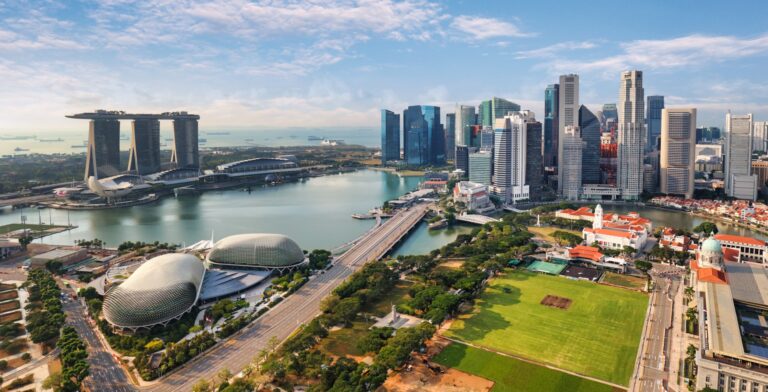This blog post about smart cities is fascinating. In order to help us comprehend and learn some of their common practices, this blog has decided to showcase three cities—the United Kingdom, Singapore, and New York—that are known for succeeding in the field of smart cities. As I read this blog, I came across a number of common practices associated with smart cities, like creating open data websites, contactless debit cards or web-based public services, putting up certain infrastructures, and so forth, to better support the growth of the city and the lives of its residents.
In successful smart city scenarios, a comprehensive planning strategy is typically used to integrate new and legacy infrastructure and applications into a system that provides a holistic view of the entire city. The Smart City of the Future concept builds on intelligent software networks that attempt to optimize the use of various applications and networks. These projects often require the use of Smart City Platform Centers to provide a comprehensive view of the different uses of Smart Cities.
Future smart city plans must be long-term and viable. Rather than focusing solely on enhancing urban mobility, smart cities must seek to use multiple technological solutions to achieve the overall goal of smart cities. Smart cities prioritize people’s needs and provide infrastructure that integrates individuals into the design process, resulting in a sense of community and engagement. They provide a contact center for the entire city, where residents are free to share their real feelings and opinions. Successful smart cities often integrate them with government initiatives in smart city programs or plans. Government-supported smart city initiatives, unlike standalone programs, are usually backed by laws and regulations to assist in their conceptualization and implementation.
References
1.Castells, M. (1996) The Rise of the Network Society: The Information Age: Economy, Society, and Culture, vol. 1. Oxford: Blackwell. Kiran, Dr Deepti; Sharma, Itisha; Garg, Illa (2020).
2.”Industry 5.0 And Smart Cities: A Futuristic Approach”. European Journal of Molecular & Clinical Medicine. 7 (8): 2750–2756. ISSN 2515-8260.
Those cities that are at the forefront of smart cities
Introduction
With the development of big data and the popularization of informatization, more and more countries have entered the era of smart cities. Therefore, this blog selects several cities that have been recognized as doing well in the field of smart cities. So that, it can help us understand some of their typical practices.

Figure1: Image of smart city (Source from https://www.sotefin.com/new-york-tops-north-americas-smart-city-rankings-in-2023/)
Selection basis
Vision: A clearly defined “smart city” development strategy.
Budget: Adequate funding for smart city projects.
Financial incentives: Such as grants, rebates, subsidies and competitions.
Support Plan: Such as incubators, events and networks.
Talent preparation: Projects to equip urban talents with smart skills.
People oriented: Sincere and people-oriented future urban design.
Smart policies: Such as data governance, intellectual property protection and urban design.
Example1: London

Figure2: Picture of London (Source from https://www.webuildvalue.com/en/megatrends/smart-city-london.html)
As early as 2009, the “Digital UK” appeared. And in 2013, the “Smart London Plan” also appeared. At this time, the goal is to better serve the development of London and the lives of its citizens with the creativity of new technologies.

Figure3: Big Data model in “Smart London Plan” (Source from https://www.london.gov.uk/sites/default/files)
The “Oyster” contactless debit card. Therefore, it will be convenient for citizens to pay 80% of public transportation service fees.
Intelligent light pillars can simultaneously provide various functions such as lighting, control systems, speakers, surveillance cameras, WLAN and electric vehicle charging stations.
The smart trash can is equipped with Wi Fi wireless network transmission function. Not only can it guide citizens to correctly classify garbage, but also it will also send information to the sanitation and cleaning department.
Establish the London Open Data website, which provides multiple data methods and all data directory download functions. Additionally, it is an internationally recognized data resource platform that achieves data sharing and improves public service destinations.
Example2: Singapore

Figure4: Picture of Singapore (Source from https://www.webuildvalue.com/en/megatrends/singapore-smart-city.html)
Basically, Singapore’s smart city governance began 40 years ago, with the goal of building Singapore into an information-driven global city and intelligent country. Also, it fundamentally changed people’s lives, communities, and future, and creating the world’s first smart country.
WiFi is ubiquitous. In 2015, Singapore was a global leader in both internet access and smartphone penetration rates: 87% of households had internet access (compared to 30% -50% in China during the same period), and 72% of the population were internet users).
What’s more, almost 90% of public services can be provided online.
Six key national strategies: CODEX, electronic payments, Moment of Life Initiative, National Digital Identification (NDI), National Intelligent Sensor Platform and Intelligent Urban Transport.
In addition, a safe, high-speed, economical and highly scalable national communication infrastructure collects data from various sensors. In fact, it analyzes further user needs and effectively shares the collected data with the public through data analysis. So that it can provide better services for the needs of the public.
High coverage of video surveillance. In the study of the number of surveillance cameras in 120 major cities worldwide, Singapore has 86000 cameras with a population of 5.6 million.
Facial recognition technology has been added to video surveillance. At this point, it’s equipped with thermal powered drones to assist in aerial surveillance.
Example3: New York
Figure5: Picture of New York (Source from https://technologymagazine.com/top10/top-10-sustainable-smart-cities-helping-make-a-better-world)
As a result, the concept of “smart city” was first posted by the American technology company IBM. Also the United States was also one of the earliest countries to promote the construction of “smart cities”.
Infrastructure: Transforming old telephone booths into all-weather wireless network service information kiosks. In fact, it provided 24/7 free internet connection, free phone calls from anywhere in the United States, free access to 911 emergency calls, and 311 city information center.
Medical: Major hospitals and community healthcare institutions in New York City generally adopt a complete electronic medical record system. It can not only facilitate doctors’ consultation of patient medical records, but also improve the accuracy of medical measures. Basically, sharing medical data and unifying archives are areas that need to be gradually strengthened in China.
Transportation: Build an intelligent transportation information system that covers the entire city. As a result, it can track and monitor the dynamic changes of all traffic conditions in the city in a timely manner.
Underground pipeline network: It can clearly display the city’s sewage pipelines and related facilities. By installing an electronic monitor under the manhole cover, timely and uninterrupted monitoring of water flow, water quality, blockage, and other conditions can be carried out.
Big Data: Incorporate all publicly available data from various departments into a unified portal and make it available on the internet.
Reference
01 E. O’Dwyer, et al. Smart energy systems for sustainable smart cities: current developments, trends and future directions. Appl Energy, 237 (2019), pp. 581-597
02 Y. Liu, et al. Intelligent edge computing for IoT-based energy management in smart cities. IEEE Netw, 33 (2) (2019), pp. 111-117
03 Z. Ullah, et al. Applications of artificial intelligence and machine learning in smart cities. Comput Commun, 154 (2020), pp. 313-323
04 Z. Allam, Z.A. Dhunny. On big data, artificial intelligence and smart cities Cities, 89 (2019), pp. 80-91




This blog post about smart cities is fascinating. In order to help us comprehend and learn some of their common practices, this blog has decided to showcase three cities—the United Kingdom, Singapore, and New York—that are known for succeeding in the field of smart cities. As I read this blog, I came across a number of common practices associated with smart cities, like creating open data websites, contactless debit cards or web-based public services, putting up certain infrastructures, and so forth, to better support the growth of the city and the lives of its residents.
In successful smart city scenarios, a comprehensive planning strategy is typically used to integrate new and legacy infrastructure and applications into a system that provides a holistic view of the entire city. The Smart City of the Future concept builds on intelligent software networks that attempt to optimize the use of various applications and networks. These projects often require the use of Smart City Platform Centers to provide a comprehensive view of the different uses of Smart Cities.
Future smart city plans must be long-term and viable. Rather than focusing solely on enhancing urban mobility, smart cities must seek to use multiple technological solutions to achieve the overall goal of smart cities. Smart cities prioritize people’s needs and provide infrastructure that integrates individuals into the design process, resulting in a sense of community and engagement. They provide a contact center for the entire city, where residents are free to share their real feelings and opinions. Successful smart cities often integrate them with government initiatives in smart city programs or plans. Government-supported smart city initiatives, unlike standalone programs, are usually backed by laws and regulations to assist in their conceptualization and implementation.
References
1.Castells, M. (1996) The Rise of the Network Society: The Information Age: Economy, Society, and Culture, vol. 1. Oxford: Blackwell. Kiran, Dr Deepti; Sharma, Itisha; Garg, Illa (2020).
2.”Industry 5.0 And Smart Cities: A Futuristic Approach”. European Journal of Molecular & Clinical Medicine. 7 (8): 2750–2756. ISSN 2515-8260.
In this blog, the author describes some factors needed to build a smart city, and makes me understand that the construction of smart city is the inevitable trend of today’s urban development.But I also want to add a few new points.
Firstly,the role of smart cities in urban governance. The concept of smart city is to provide better urban services for people based on their needs. Smart cities achieve more refined and intelligent management of urban governance through big data, artificial intelligence and other technologies. For example, through urban big data analysis, real-time monitoring of road information, as well as the construction of intelligent transportation facilities, the overall deployment of public resources, etc., all provide better protection for the operation of the city. In this way, we can live in the city more safely, quickly and comfortably.Secondly,how smart cities enhance the sustainable development capacity of cities?If the city is to develop and grow continuously, it needs to have sustainable development capacity. Through the establishment of digital urban operation and management system, smart city realizes the rational planning and management of urban resources, and lays a solid foundation for the sustainable development of the city. For example, through green transportation facilities, energy conservation and emission reduction, intelligent waste classification, etc., the burden on the urban environment is reduced, natural data is protected, and benign interaction with the environment is realized.Thirdly,the future of smart cities. Smart city is only one of the urban construction directions in the digital age, and there are still many unknown possibilities and challenges waiting for us to accept and explore. With the rapid development of technology, the application scenarios and forms of smart cities are bound to change more. In the future, we will see smart cities bring us more convenient, smarter lives, and more sustainable urban operations.
Finally,smart cities are changing our lives and shaping the shape of cities. Obviously, the construction of smart cities is faced with many practical problems such as technology and security, and in the process of overcoming these problems, the further deepening of urbanization and the application of digital space-time will increasingly become a trend.
References:
1.Deakin, M (2007). “From city of bits to e-topia: taking the thesis on digitally-inclusive regeneration full circle”. Journal of Urban Technology. 14 (3): 131–143. Archived from the original on 18 March 2016. Retrieved 3 November 2014.
2.César de Lima Araújo, Henrique; Silva Martins, Fellipe; Tucunduva Philippi Cortese, Tatiana; Locosselli, Giuliano Maselli (2021). “Artificial intelligence in urban forestry—A systematic review”. Urban Forestry and Urban Greening. 66: 127410. doi:10.1016/j.ufug.2021.127410. S2CID 244416741.
3.Fernanda Medina Macaya, Javiera; Ben Dhaou, Soumaya; Cunha, Maria Alexandra (6 October 2021). “Gendering the Smart Cities:: Addressing gender inequalities in urban spaces” (PDF). 14th International Conference on Theory and Practice of Electronic Governance. pp. 398–405.